Climate Ready Scotland: climate change adaptation programme 2019-2024
A five year programme to prepare Scotland for the challenges we will face as our climate continues to change.
Outcome 1: Our communities are inclusive, empowered, resilient and safe in response to the changing climate

Image 1.1. Edinburgh Castle
Introduction
Our communities are shaped by the quality and character of the places we live and the people we live among. In order for Scotland to continue to flourish, we must ensure that our communities are able to adapt to the effects of climate change. As communities will form a fundamental component of our ability to adapt, our Programme begins with a focus on communities.
A community is defined as a social group of any size whose members reside in a specific locality, share government and often have a common cultural and historical heritage. Scotland’s geography and history has led to the creation of diverse communities: from remote highland and island villages and towns, to the cosmopolitan cities of the central belt.
The changing climate will impact all of Scotland’s communities and each community will be affected in different ways. Across Scotland, climate change will bring hotter, drier summers and warmer, wetter winters. In summer, more intense rainfall could bring heavy rainstorms with increased surface water flooding. In winter, more frequent rainfall could bring increased flooding from rivers and increased damage to buildings from wind driven rain. Increased storminess could result in increased coastal erosion, surges and wave overtopping of coastal defences and infrastructure. Sea level rise could affect the viability of some coastal communities through flooding and erosion.
Local communities will need to take action to adapt to climate change, some sooner than others, depending on the local geography and social and economic conditions. The Scottish Government believes that communities are best placed to make decisions and take action themselves, shaped by their own local geographies and demographics.
Where We Are Now
Through our Climate Ready Places work, there has been increasing focus on increasing resilience at the community, city and regional levels. Initiatives such as Climate Ready Clyde, Edinburgh Adapts and Aberdeen Adapts have laid strong groundwork to create climate change action plans for those areas. In combination with work from Adaptation Scotland, these initiatives and others also work to empower their local communities to deal with the effects of climate change through education and planning.
Building on a strong history of legislation relating to community empowerment, the Community Empowerment (Scotland) Act 2015 made adjustments to address and improve community rights in relation to land and the Right to Buy. The Land Reform (Scotland) Act 2016 also built on this work, establishing the Scottish Land Commission and making provision for changes to land ownership and management.
In Scotland, the Flood Risk Management (Scotland) Act 2009, creates a framework for coordination and cooperation at a national and local level. It is underpinned by a National Flood Risk Assessment that embeds climate change into the heart of Scotland’s flood risk management approach, whilst combining a comprehensive range of social, environmental and economic impacts into a single assessment. Flood risk management strategies and local flood risk management plans ensure long-term proactive planning and investment decisions protect the most vulnerable and those areas at greatest risk of flooding across the whole of Scotland.
Communities Sub-Outcomes
Placemaking is a multi-faceted approach to revitalising, planning, designing and managing places. It involves working with local people to discover what their priorities are for their local areas. Placemaking and place-based approaches are a useful way to consider adaptation to climate change. Approaches based on ‘place’ can offer a more holistic view by regarding the interactions and connections between different elements of a community. The Sub-Outcomes have been structured in line with these elements. The first relates to the social aspects of community, such as empowerment, engagement and adaptability; the second Sub-Outcome relates to the physical aspects of community, including the built and historic environment. For aspects related to vulnerable people within communities, see Outcome 2.
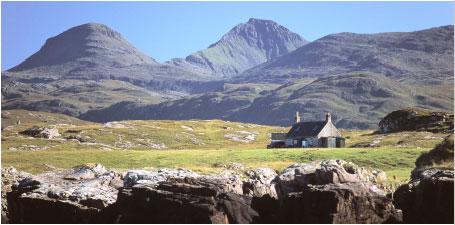
Image 1.2. Rum National Nature Reserve (© Lorne Gill, SNH)
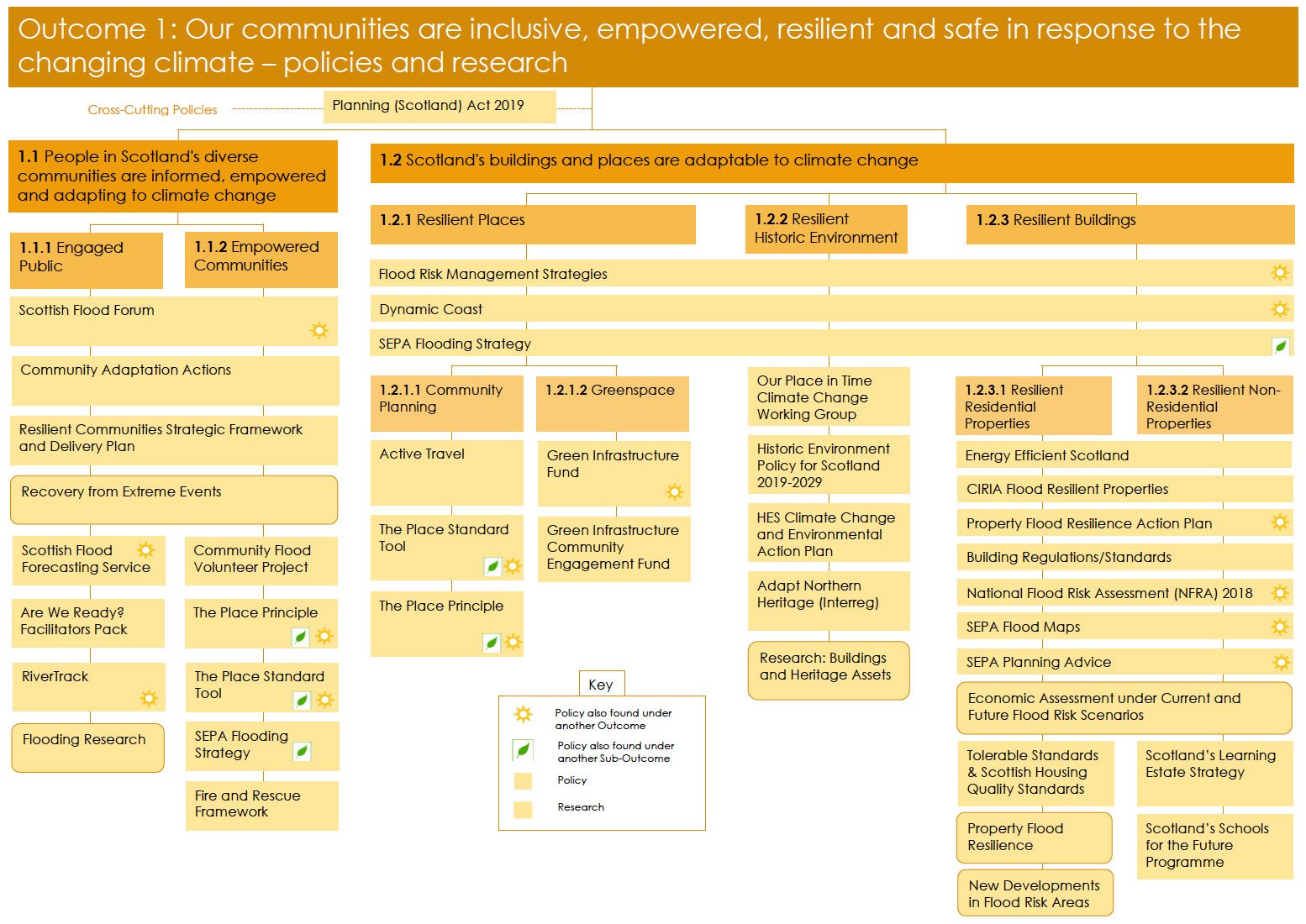
Cross-Cutting Policies
Community influence within the planning system is an important aspect of improving communities’ ability to adapt. Building and maintaining a relationship with communities in relation to plans and projects helps to deliver quality places that meet people’s needs and aspirations. In this way, the planning system cuts across both the empowerment and built environment aspects of this outcome.
| Planning (Scotland) Act 2019 |
|---|
| The Planning (Scotland) Bill was passed by the Scottish Parliament on 20 June 2019, and received Royal Assent on 25 July 2019. The Act includes a number of elements, which put communities and interested people and organisations at the heart of land-use planning. Many of these provisions work to enhance the engagement and empowerment of communities in the planning system. Community led preparation of Local Place Plans will mean that communities can lead in setting out the vision for their areas, and could consider climate change adaptation matters. Empowered communities engaged in the planning system will be more able to take forward plans that will increase local resilience to climate change impacts. Now that the Bill has received Royal Assent, the Scottish Government will work collaboratively with partners, including communities, on a future programme of work to implement the new requirements, and review national planning policy in Scotland. |
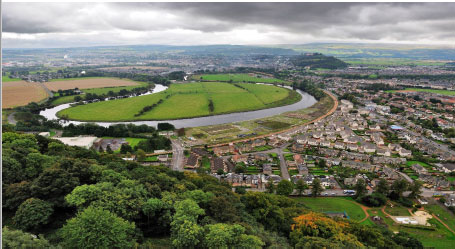
Image 1.3. River Forth, Stirling (© Lorne Gill, SNH)
Sub-Outcome 1.1: People in Scotland’s diverse communities are informed, empowered and adapting to climate change
Community empowerment is a process where people work together to make change happen in their communities by having more power and influence over what matters to them. It involves people taking collective action to enable change to happen on their own terms. Where communities are empowered, we see a range of benefits: local democratic participation is boosted, confidence and skills among local people are increased, higher numbers of people volunteer in their communities, and satisfaction with quality of life in local neighbourhoods is improved. This leads ultimately to the delivery of improved, more responsive services and better outcomes.
The Scottish Government believes that empowered and informed communities will be essential for Scotland to adapt to the changing climate. We also believe that the best people to decide the future of communities are the people who live in those communities. The policies that fall under this Sub-Outcome aim to empower and inform communities. We want to enable people to make informed choices about how best to adapt their community to the changing climate, while also considering their local knowledge and passion for their communities.
Cross-Cutting Policies
| Scottish Flood Forum |
|
|---|---|
| The Scottish Flood Forum is an independent Scottish charity that provides support in the event of flooding, and has established a network of community resilience groups in areas at risk of flooding, to enable communities to help themselves. The grant for the Scottish Flood Forum is provided on a year by year basis and has been signed off for £190,000 for 2019-20. We aim to continue to fund the Scottish Flood Forum in the coming years to support individuals and communities at risk of flooding. |
|
| Timeline: Ongoing, annual |
Owners: Scottish Flood Forum, Scottish Government |
| Community Adaptation Actions |
|
|---|---|
| The Community Adaptation Actions document describes practical actions that communities can take to increase resilience and adapt to changes in the climate. The document describes 20 actions, split over three categories: 1. Community adaptation in the natural environment. 2. Community adaptation for built assets (schools, community centres, homes). 3. Community adaptation to raise awareness and build capacity to adapt. Each action includes information on what climate change impact will be addressed, how the action supports adaptation, co-benefits of the action, what organisations could be involved and, where available, a case study of where the action has been undertaken. More information on community adaptation actions can be found here. |
|
| Timeline: Ongoing |
Owners: Adaptation Scotland |
| Resilient Communities Strategic Framework and Delivery Plan (2017-2021) |
|
|---|---|
| The strategic aim of this plan is to support Scotland’s communities, individuals and organisations to harness resources and expertise to help themselves assess and understand risk, including climate change, take appropriate measures to prevent, prepare for, respond to and recover from emergencies, in a way that complements the work of the emergency responders. Engaged public The public have a greater understanding of the risks they face and take appropriate action to prepare for emergencies. People help others in their communities. Empowered communities Communities are empowered and supported to take collective action to address the resilience issues that affect them, by developing local initiatives and plans, that complement the actions of the Emergency Responders. Enabled collaboration and co-production Public, private, voluntary, and other civil society organisations work together effectively through the Integrated Emergency Management (IEM) process to assess and mitigate risk, prepare for, respond to and recover from emergencies. Education and learning Resilience is embedded in teaching practice as part of the Curriculum for Excellence, and is delivered in formal and informal educational settings by teachers and youth workers, working with responders. Evaluation and improvement A positive culture of evaluation underpins innovation and supports stakeholder effort, maximising the tangible and intangible resources of both the Scottish Government and other stakeholders. |
|
| Timeline: 2017 to 2021 |
Owners: Scottish Government |
Recovery from Extreme Events
The Second Independent Assessment of the SCCAP carried out by the Committee on Climate Change identified a lack of national targets and data to measure recovery from extreme events and a need to improve the effectiveness of recovery plans. A study to set national standards will enable a common understanding of climate resilience and the critical components in planning for local and national recovery from extreme weather.
Future Research
1.1.1 Engaged Public
For communities to adapt to climate change, they must first be informed and understand the potential risks and opportunities for their community. The following policies will help to engage the public with climate change and adaptation, by providing up to date information about climate change impacts in different communities.
| Scottish Flood Forecasting Service |
|
|---|---|
| The Scottish Government has invested significantly in improving and supporting the continued development of Scotland’s flood warning service, which will be increasingly important as our climate changes. This includes funding to help SEPA and the Met Office operate the Scottish Flood Forecasting Service. This service ensures flood forecasting and warning information is made available to the public and emergency responders throughout Scotland. The service includes a daily Flood Guidance Statement, issued to over 500 emergency responders. This provides shared understanding of current and forthcoming flood risk levels and locations, and advance notice of potential flooding situations to aid planning and coordination of the appropriate emergency response. Floodline’s direct warning service is available to members of the public and sends an alert to subscribers when their postcode is at risk of flooding. The Flood Warning Development Framework (2017-2021) sets out plans to enhance the coverage and delivery of flood warning, including 14 new flood warning schemes that have been strategically identified, and prioritised. |
|
| Timeline: Scottish Government funds SEPA annually to operate the Scottish Flood Forecasting Service New flood warning schemes: Annick Water (Ayrshire), Outer Hebrides coast (2019); River Carrion (Falkirk), River Forth (Aberfoyle) (2020); Fife catchments (subject to feasibility assessment) (2021) |
Owners: SEPA, The Met Office |
| Are We Ready? Facilitators Pack |
|
|---|---|
| How can your community be better prepared for the impacts of climate change? ‘Are We Ready?’ is a resource for communities to talk about our changing climate as a starting point for getting climate ready. This resource includes a short film, information about the key consequences of climate change and a guide to running the Are We Ready? workshop in communities. |
|
| Timeline: Ongoing |
Owners: Adaptation Scotland |
| RiverTrack |
|---|
| RiverTrack community flood warning is a low cost sensor system that provides real time water levels to local communities where traditional flood warning schemes are not available. More information on this policy can be found in Section 3.3.1. |
Flooding Research
The Scottish Government will continue to fund research and pilot projects to ensure policy is based on the latest evidence. Currently, the Scottish Government funds a wide range of research which includes centres of expertise on water (CREW), and on climate change (ClimateXChange). The centres of expertise are taking forward a number of research projects related to flood risk management and climate change, including:
- Assessing the impacts of winter 2015-16 flooding in and around Ballater, and in the Garioch with a three year study on community impact (more information on this project can be found in Section 2.2.2.2.),
- Using climate projections in economic appraisal for flood risk management measures,
- An assessment of floodplain loss.
We will also support opportunities for knowledge exchange and best practice to be shared.
Research
1.1.2 Empowered Communities
Empowered communities are able to take forward their understanding of how climate change will impact their community, and take action to improve local resilience. When combined, engaged and empowered communities support people in Scotland to be adaptable to the changing climate. The following policies support community empowerment.
| Empowering Communities: Community Flood Volunteer Project |
|
|---|---|
| Community volunteers are trained by The Conservation Volunteers, who are a community volunteering charity providing opportunities to help people protect and enhance their local greenspace and biodiversity. Volunteers are then equipped by the local authority to assess watercourses, report blockages to the local authority, and maintain priority watercourses themselves if safe to do so. Climate change is projected to increase the risk of flooding in Scotland. This novel approach enables communities to improve their resilience to respond and recover from flooding. |
|
| Timeline: Ongoing |
Owners: Scottish Government, The Conservation Volunteers, Local Authorities |
| The Place Principle |
|
|---|---|
| The Place Principle calls on all those responsible for providing services and looking after assets in a place to work and plan together, and with local communities, to improve the lives of people, support inclusive and sustainable growth and create more successful places that will be capable of adapting to climate change. We will promote the adoption of the Place Principle across Scotland through targeted public events, creation of a Place website, and liaising to embed the Place Principle across government. By doing this, we will ensure that places are shaped by the way resources, services and assets are directed and used by the people who live in and invest in them. |
|
| Timeline: Ongoing |
Owners: Scottish Government, COSLA |
| The Place Standard Tool |
|
|---|---|
| The Place Standard is a tool to evaluate the quality of places and to help communities, public authorities and industry to work together to create places that can support a high quality of life and protect and enhance the environment. An ongoing programme of work to support the Place Standard and place-based working will promote the relationships and opportunities that place-based approaches can provide for the climate change adaptation agenda. This will strengthen the relationship between place and climate change adaptation and mitigation, and promote co-benefits, particularly in relation to health and wellbeing, and tackling inequality. We will scale up the use and impact of the Place Standard tool across Scotland to increase participation and community engagement with local decision-making processes and deliver effective place-based approaches. |
|
| Timeline: The Place Standard was launched in 2015 and a new programme of work to support the use of the tool and place-based working will cover 2020-2023. |
Owners: Scottish Government, NHS Health Scotland and Architecture & Design Scotland, with support from Glasgow City Council and the Improvement Service. |
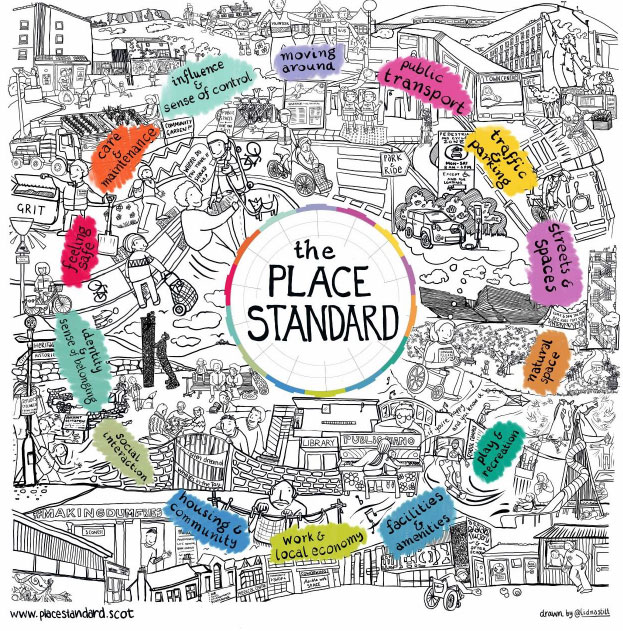
Image 1.4. Visualisation of the Place Standard Tool (© Linda Hunter)
| SEPA Flooding Strategy |
|
|---|---|
| SEPA is producing a Flooding Strategy which will help to steer and focus their statutory role and responsibilities for flooding. It aims to embed adaptation as a key principle to ensure flood risk management plans and actions tackle future flood risk. The Strategy aims to support individual and community resilience to flooding and take forward flood risk management, involving a wide range of powerful partnerships working to increase Scotland’s flood resilience now and in the future. |
|
| Timeline: Publication target of 2020 |
Owners: SEPA |
| Fire and Rescue Framework for Scotland |
|
|---|---|
| The Scottish Government’s Fire and Rescue Framework for Scotland explains that as our climate changes, more communities across Scotland will face risks from flooding than ever before. Moreover, evidence indicates that the impact of such events has increased in financial terms as well as in human terms. There is projected to be a significant rise in the proportion of people in Scotland who are over 65. This means that during storms and heat waves, there may be an increase in the number of elderly and vulnerable people trapped within their homes requiring rescue from flooding or severe weather. The Framework states that the Scottish Fire and Rescue Service (SFRS) should have an increasing focus on building resilience in relation to flood risk as well as other threats. A key factor in managing such incidents and in keeping communities safer in general is the resilience of communities themselves. Resilient communities can better withstand adverse events and the Framework notes that SFRS should work together with other public services to enable and support communities to develop and enhance their own resilience. |
|
| Timeline: Ongoing |
Owners: Scottish Government |
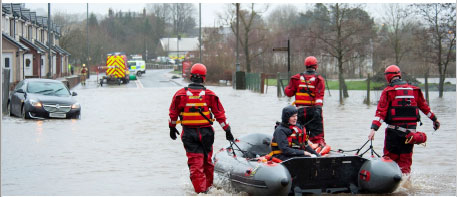
Image 1.5. Scottish Fire and Rescue Service provide assistance during flood event (© SFRS)
Sub-Outcome 1.2: Scotland’s buildings and places are adaptable to Climate Change
In 2016, there were 2.58 million residential dwellings in Scotland. It is likely that 80% of housing in use today will still be in use in 2050. The residential sector is diverse and varies in tenure, age, heating and building technique. Three quarters of our homes were built before 1982 and one fifth before 1919. Our current built environment will therefore need to adapt to our changing climate, and in particular, the likely projected increases in temperature (with greater warming in the summer than winter) and projected increases in rainfall in winter and reduced rainfall in summer. As the climate changes, an increasing number of buildings will become at risk of flooding and the increased storminess that we expect may pose a further risk to the fabric of Scottish buildings that were not designed for these weather conditions.
Cross-Cutting Policies
| Flood Risk Management Strategies |
|
|---|---|
| Flood risk management in Scotland is risk based and plan led, with strategies setting the national direction of future flood risk management in Scotland. They coordinate action across public bodies to where the risk of flooding and benefits of investment are greatest, and give individuals, communities and businesses the information to better manage their own responsibilities. Actions[2] that will tackle flooding in high risk areas, are described and prioritised in six-year planning cycles. There are 14 Local Plan Districts in Scotland, each with their own strategy. The strategies are approved by the Scottish Government and published by SEPA as Scotland’s strategic flood risk management authority. Scotland’s Flood Risk Management Strategies set out the short to long term ambition for flood risk management, with climate change and social justice embedded in the approach. Since 2008, the Scottish Government has made funding available of £42 million per year (via the Capital settlement) to enable local authorities to invest in flood risk management actions. This level of funding has been guaranteed until 2025-26. |
|
| Timeline: The strategy is updated every 6 years. |
Owners: SEPA, Local Authorities, Scottish Water |
| Dynamic Coast |
|---|
| The second phase of Dynamic Coast will investigate the resilience of Scotland’s natural coastal defences (for example, identifying where low dunes may breach); estimate how future climate change may exacerbate erosion on our soft (erodible) coast; and develop mitigation, adaptation and resilience plans at super sites, including St Andrews and Montrose. More details on this policy can be found under Sub-Outcome 6.1. |
| SEPA Flooding Strategy |
|---|
| SEPA is producing a Flooding Strategy which will help to steer and focus their statutory role and responsibilities for flooding, including support for individual and community resilience. More details are provided in Section 1.1.2. |
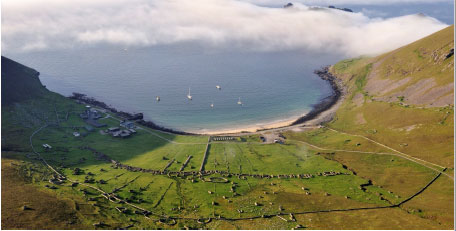
Image 1.6. St Kilda National Nature Reserve (© Lorne Gill, SNH)
1.2.1 Resilient Places
The concept of place considers physical and social elements. Physical elements of place include the buildings, spaces and transport, while social elements include people’s identity and whether they feel they have a say in decision making. For a place to be resilient, these elements of place must be supported. While Sub-Outcome 1.1 deals with social aspects of place, the following policies focus on the physical aspects of place, specifically spaces. More information on resilient buildings can be found in Section 1.2.3, and information on the resilience of transport systems is included in the Supporting Systems chapter.
1.2.1.1 Community Planning
Community planning focusses on public bodies, and how they work together with local communities to design and deliver better services that make a difference to people’s lives. Appropriately designed communities will consider climate change in their planning, and will therefore be more adaptable to change. Planning of communities is also linked closely with community empowerment, as the people best placed to make decisions about how their community develops are those that live there.
| Active Travel |
|
|---|---|
| The Active Travel vision is for walking and cycling to be the most popular mode of travel for short, everyday journeys. We want to make Scotland's towns and cities friendlier, safer and more accessible. Active Travel is fundamental to the development of a sustainable travel network and a key priority for the Programme for Government. The budget was doubled in 2018-19, with that funding sustained for 2019-20. This funding will be used to improve Scotland’s active travel infrastructure and as a result its ability to adapt to the changing climate. |
|
| Timeline: Ongoing |
Owners: Scottish Government |
| The Place Standard Tool |
|---|
| The Place Standard is a tool to evaluate the quality of places and to help communities, public authorities and industry to work together to create places that can support a high quality of life and protect and enhance the environment. More details are provided in Section 1.1.2. |
| The Place Principle |
|---|
| The Place Principle recognises the importance of places at the heart of communities and promotes a more collaborative and participative approach to services, land and buildings. More details are provided in Section 1.1.2. |
1.2.1.2 Greenspace
Greenspaces provide important benefits for both people and the environment, and can be easily integrated into a place to make it more resilient and adaptable to the effects of climate change. This is predominantly carried out through green infrastructure projects. Improving the quality of our urban and rural environments is vital if we are to deliver on our ambition to make Scotland a greener, wealthier and fairer, smarter, healthier, stronger and more resilient country. Green infrastructure approaches can offer additional benefits compared with conventional approaches to open space planning because they offer greater functionality. They can offer an environmentally friendly approach to development and infrastructure planning. Well-designed green infrastructure and creatively designed greenspaces offer lots of benefits and can support multiple agendas by helping to develop communities and places that are sustainable, attract residents and businesses, support healthy lifestyles and encourage the kinds of behaviour that contribute towards the success of places in social, economic and environmental terms.
| Green Infrastructure Fund |
|
|---|---|
| The Green Infrastructure Fund aims to improve Scotland’s urban environment by increasing and enhancing greenspace in our towns and cities, especially close to areas of multiple deprivation. This will improve climate change resilience, health and well-being, reduce social isolation and make these areas more attractive for people to live and work in, attracting jobs, businesses and further investment. SNH intend to deliver a minimum of 15 capital projects across Scotland that improve or create at least 140 hectares of urban green infrastructure. They also intend to deliver 10-15 smaller community engagement projects where the focus is on working with people to help them make the most of their local greenspace. |
|
| Timeline: 2019-20 complete Phase 1 projects. Funding awarded to a further 10 capital investment projects. |
Owners: SNH |
Case Study 1: Canal and North Gateway, Glasgow
This flagship project supported by the Green Infrastructure Fund is an example of how blue-green infrastructure can underpin local regeneration. In response to the changing climate, and the increased risk from flooding, the purpose of this project is to develop an innovative surface water management solution. Co-benefits of this project include providing biodiversity corridors and access routes along the canal for local communities.
Surface water management is delivered through a combination approach of canal water level management and Sustainable Drainage Systems (SuDS). Based on weather forecasting, the water level in the canal can be lowered in advance of extreme weather, and excess water taken up by SuDS.
The land used to develop this scheme was previously vacant and derelict, contributing to overall themes of place-making that are so important for local communities.
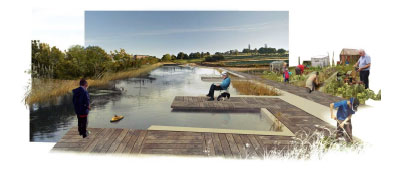
Image 1.7. Canal and North Gateway (© Green Infrastructure Scotland)
| Green Infrastructure Community Engagement Fund |
|
|---|---|
| The Green Infrastructure Community Engagement Fund launched in 2017 and delivers £1.2 million worth of community engagement projects in Scotland’s cities and larger towns. The fund is primarily used to support the employment of project staff to work with communities, helping them make better use of their greenspace, or develop their own proposals on how it could be improved. The development of green infrastructure within our towns and cities will support their adaptation to climate change by providing space for natural flood management and increasing biodiversity. The Community Engagement Fund aims to ensure that communities are connected to nature and are able to shape its improvement in their local area. |
|
| Timeline: 2017-2019 |
Owners: SNH |
Case Study 2: 10,000 Raingardens for Scotland (Glasgow Pilot)
Central Scotland Green Network Trust (CSGNT)
As climate change will lead to an increase in rainfall and flood events, innovative methods of surface water management are needed. Raingardens are a form of green infrastructure that provide multiple co-benefits, including surface water management, flood alleviation and greenspace creation, which also enhances local biodiversity and community wellbeing. They can range in style, from spaces installed and managed by individuals, or projects such as the raingarden under construction at the Royal Botanic Garden Edinburgh.
As part of the 10,000 Raingardens for Scotland project, CSGNT employed a Raingarden Officer to deliver community information and engagement sessions with the aim of encouraging individuals and communities to set up their own raingardens. The project is currently in the pilot stage, and is being trialled in Glasgow as the city regularly experiences flooding and surface water management issues, which the current drain and sewer system struggle to cope with. The project will trial and monitor the ability of raingardens and nature-based systems to alleviate the impacts of flooding and disseminate this learning.
1.2.2 Resilient Historic Environment
While Scotland’s historic environment is inherently resilient, a lack of care and maintenance can make it vulnerable to the changing climate. Changing climatic conditions can alter and accelerate decay processes of historic places, and buildings may become less able to cope with changing weather patterns caused by climate change.
| Our Place in Time: the Historic Environment Strategy for Scotland (OPiT) – Climate Change Working Group |
|
|---|---|
| The historic environment sector is disparate, and its interface with the climate change agenda complex, for example through individual sub-sectors related to traditional buildings, archaeology, tourism, landscape, collections, materials and skills. This situation requires a focused approach targeting specific sub-sectors in order. A working group has been established under OPiT, to enable the historic environment sector to coordinate action on climate change. The key deliverable for the Working Group is the ‘Climate Change Impacts Guide for the Historic Environment’. This guide provides an introduction to the direct physical impacts of climate change on various types of historic asset in Scotland. It is intended as a resource for understanding what climate change means for Scotland’s historic environment. The aim of the guide is to:
|
|
| Timeline: Ongoing – October 2019 |
Owners: Historic environment sector, led and enabled by Historic Environment Scotland |
| Historic Environment Policy for Scotland (2019-2029) |
|
|---|---|
| Historic Environment Policy for Scotland (HEPS) sets out a series of policies and principles for the recognition, care, management and sustainable use for the whole of the historic environment. HEPS specifically recognises the significant challenges that a changing climate represent for the historic environment. The core principles contained within HEPS are informed by an understanding of the need for decision making affecting the historic environment to recognise and respond to ongoing climate change and support reduction in carbon emissions and waste. Further detailed advice that supports this policy can be found in the Managing Change in the Historic Environment guidance notes. These serve to inform good decision making and cover a variety of areas such as micro-renewables, gardens and designed landscapes and windows which offer advice and information on climate change and its effect on historic environment assets as well as energy efficiency. |
|
| Timeline: 2019-2029 |
Owners: Historic Environment Scotland |
| Historic Environment Scotland Climate Change and Environmental Action Plan (CCEAP) |
|
|---|---|
| This sets out Historic Environment Scotland’s approach to addressing the challenges and opportunities presented by climate change to the organisation and the wider historic environment. Actions in this CCEAP are articulated under strategic themes that have been identified as core areas of climate change work and research for HES. The CCEAP details how we will work towards making our organisation and the broader historic environment more resilient to and prepared for changes in our climate, alongside playing a leading role in supporting the Scottish Government to meet its ambitious carbon emission reduction targets. |
|
| Timeline: 2019-2024 |
Owners: Historic Environment Scotland |
| Adapt Northern Heritage (Interreg) |
|
|---|---|
| Adapt Northern Heritage is a project supporting communities and local authorities to adapt northern cultural heritage to the environmental impacts of climate change and associated natural hazards through community engagement and informed conservation planning. The project involves four Project Partners and eleven Associated Partners from Iceland, Ireland, Norway, Russia, Scotland and Sweden and is supported by Iceland, Norway and the European Union through the Interreg programme for the Northern Periphery and Arctic. The Project Partners, including Historic Environment Scotland, are developing a risk assessment method for historic places, and associated guidance for their adaptation. This method is being trialled and demonstrated using nine case studies from across northern Europe, and its future use will be supported by an expert conservation network. |
|
| Timeline: June 2017 to May 2020 |
Owners: Historic Environment Scotland (Project Lead) |
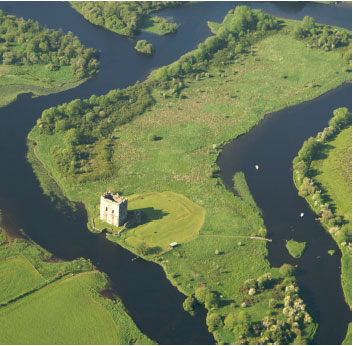
Image 1.8. Threave Castle (© Historic Environment Scotland)
Research for Buildings and Heritage Assets
Historic Environment Scotland have commissioned a number of research themes to improve the resilience of the historic environment in Scotland:
- Thermal performance of the traditional building envelope and upgrading options available to older structures to improve energy efficiency;
- Physical effects on buildings of changing weather patterns and profiles, including rates of decay for materials, building components; soils and sediments;
- Quantify heritage assets affected by climate change;
- Collate action on understanding and mapping anticipated risk to cultural heritage; and
- Pilot studies of adaptation methodologies in the historic environment.
This research will be published and will be used to inform new guidance and updates to existing guidance. It will also be disseminated through training and events, delivered via HES Engine Shed.
Research
1.2.3 Resilient Buildings
Ensuring that buildings are resilient will go a long way in helping communities adapt to the changing climate. As the climate changes, Scotland will experience an increase in frequency of heavy rain and storms as well as high temperatures and heatwaves. These changes to weather can cause damage to Scotland’s buildings. Buildings can be considered more resilient when they are energy efficient; have well-regulated internal temperatures; are not easily damaged by wind, rain, or flooding; and are not susceptible to damp.
Cross-Cutting Policies
| Energy Efficient Scotland |
|
|---|---|
| Energy Efficient Scotland is a 20 year programme that will make our homes and buildings warmer, greener and more efficient and by 2040 will ensure that:
Energy Efficient Scotland will put in place a framework of standards making it the norm to invest in energy efficiency improvements. It will also continue to provide significant support to help households and businesses install energy efficiency measures, through a combination of grants and low-cost loans as well as drawing in other private and public resources. By 2021 the Scottish Government will have allocated more than £1 billion since 2008 to improving energy efficiency. Promoting investment in Scotland’s built environment will have additional positive effects including improving the building fabric of both residential and commercial properties. Effective Installation of energy efficiency measures, such as external wall insulation, can improve the resilience of Scotland’s buildings to the increased adverse weather projected as a result of climate change. |
|
| Timeline: 2018-2040 |
Owners: Scottish Government, local authorities, social landlords, private landlords, owner occupiers, non-domestic building owners |
| CIRIA Flood Resilient Properties Code of Practice |
|
|---|---|
| The Scottish Government is working with partners across the UK to develop a Code of Practice for resilient flood repairs and property level protection. The Code of Practice will consider the increased risk associated with climate change. The project will develop guidance documents to provide an integrated and authoritative framework that supports good practice and enable property owners, managers and built environment professionals to competently and confidently specify and deliver property flood resilience. The outputs are being developed with a range of stakeholders including the insurance industry and will help deliver the flood resilient properties action plan. |
|
| Timeline: CIRIA guidance to be available autumn 2019 |
Owners: Scottish Government, Property Flood Resilience Delivery Group |
| Property Flood Resilience Action Plan |
|
|---|---|
| Flooding will become more frequent in the future, with some properties flooding repeatedly. The Scottish Government is working with a range of stakeholders including SEPA, the Scottish Flood Forum, The Association of British Insurers, Flood Re, BRE and local authorities to develop an action plan to improve the resilience of properties at flood risk. Flood resilient properties are an important part of the response to current and future flood risk, particularly in areas where formal flood protection schemes are not suitable. Property Flood Resilience (PFR) measures are designed to make buildings more resilient to the physical impacts, and people to the emotional impacts of flooding. PFR can be used for all types of flood risk, including river, coastal, surface water, groundwater and sewer. Properties need a package of measures, some of which prevent water entering a house and others that minimise the impact should water enter the house, speeding up the recovery process. Sometimes the water should be let in; in some instances attempting to keep the water out can cause serious structural damage. It is important that each building is properly surveyed and the flood risk understood prior to resilience measures being designed and installed. The PFR action plan recommends a number of actions that will help to deliver property flood resilience. |
|
| Timeline: Completed June 2019, and due for publication in autumn 2019. |
Owners: Scottish Government, Property Flood Resilience Delivery Group |
| Building Regulations/Standards |
|
|---|---|
| Scottish building regulations set standards for new buildings and where new work is undertaken to existing buildings. Regulations set out mandatory functional standards that must be met when undertaking building work and provide guidance on one or more ways of meeting these standards. The application of these standards is verified at building design stage and on completion by Scottish local authorities who are appointed as ‘verifiers’ of the building standards system. Responsibility for compliance with regulations rests with the ‘relevant person’, commonly the building owner or developer. Review of these standards considers the potential impact to buildings and building users of future changes to our climate as relevant to the review topic. Within the mandatory functional standards, provisions are currently set out to address the resilience of buildings to the effects of weather, risk from flood and risk of overheating. Standards also act to limit energy demand and water demand in buildings. |
|
| Timeline: A review of energy standards is underway, with implementation programmed for 2021. This review will include further consideration of how standards mitigate overheating risk in new buildings, considering future climate predictions. |
Owners: Scottish Government |
| National Flood Risk Assessment (NFRA) 2018 |
|
|---|---|
| The National Flood Risk Assessment is the first step to protect and prepare communities at flood risk by improving our understanding of what and where is potentially at risk of flooding including consideration of climate change. The NFRA assesses the relative adverse consequences of flooding across Scotland and produces a high-level overview of flood risk. The assessment enables identification of locations with the greatest flood risk, these areas are designated as Potentially Vulnerable Areas. Areas may be vulnerable due to current or future flood risk to people, the environment, cultural heritage and economic activity. The revised NFRA also includes classification of property types and infrastructure at risk of flooding. This allows improved assessments of risks to sector, business and asset types and can be used to inform appropriate flood risk management actions. |
|
| Timeline: Revised every 6 years. Next assessment 2024 |
Owners: Scottish Government, SEPA |
| SEPA Flood Maps |
|
|---|---|
| SEPA’s flood maps illustrate where flooding may happen so that people can check whether they live in an area that is at risk. The flood maps help SEPA and other authorities identify the most effective actions to manage flood risk and develop plans to tackle flooding. They support sustainable approaches to managing flood risk, and enable better planning decisions to avoid unnecessary development in high flood risk areas. Climate change projections and their impact on flooding in Scotland are integrated into the development of SEPA’s flood maps. |
|
| Timeline: Ongoing |
Owners: SEPA |
| SEPA Planning Advice |
|
|---|---|
| SEPA provide support for Planning Authorities to ensure they make informed decisions about appropriate development where flooding impacts are minimised. This assists planning authorities to promote development in areas where communities can thrive without the risk of flooding in the future. |
|
| Timeline: Ongoing |
Owners: SEPA |
Economic Assessment Under Current and Future Flood Risk Scenarios
This project will help improve understanding of Scotland’s investment in flood risk management under different climate change scenarios.
Future Research
1.2.3.1 Resilient Residential Properties
Residential properties need to be resilient to the changes in Scotland’s weather as the climate changes. The place in which people live can have far reaching impacts on their health and wellbeing. Housing will be more adaptable to climate change if it is designed and maintained to enable fast recovery after an extreme weather or flood event. The risk of damp may increase due to increased rainfall as a result of climate change. Residential buildings that are well insulated and ventilated will be more resilient as the climate changes.
| Tolerable Standards and Scottish Housing Quality Standards |
|
|---|---|
| The changing climate will impact the standard of Scotland’s housing stock. As the climate changes, the fabric of our homes will need to be maintained to ensure that they are resilient to increased extreme weather and wind driven rain. The tolerable standard provides a minimum condemnatory standard which all houses in Scotland must meet. The standard includes being substantially free from rising and penetrating damp as well as having satisfactory thermal insulation (defined as the presence of loft insulation where a property can have it). The Repairing Standard applies to private rented housing and requires houses to be wind and water tight and in all other respects reasonably fit for human habitation, and the structure and exterior of the house (including drains, gutters and external pipes) to be in a reasonable state of repair and in proper working order. The Scottish Housing Quality Standard requires social housing to be in a reasonable state of repair and to have a minimum standard of energy efficiency. Registered social landlords are also required to be working towards the Energy Efficiency Standard for Social Housing. These policies require houses to be in a good physical condition reducing water penetration and heat loss, which reduce the energy required to heat homes and increase their resilience to climate change. The Scottish Housing Quality Standard also includes specific measures and targets to improve the efficiency of homes in the social rented sector. |
|
| Timeline: Tolerable Standard – Currently in force. Repairing Standard – Currently in force Scottish Housing Quality Standard – Currently in force First milestone of Energy Efficient Scotland – December 2020 |
Owners: Scottish Government, local authorities, social landlords |
Property Flood Resilience
Research, analysis and evidence will be required to support the delivery of the Property Flood Resilience Action Plan. The development of the action plan is a Programme for Government commitment and will be launched later in 2019. Research needs to support the development of the Action Plan will be identified over the next months.
Future Research
New Developments in Flood Risk Areas
The absence of trend data for new developments in flood risk areas is highlighted in both Scottish Climate Change Adaptation Programme Independent Assessments.
A new study will explore data collection processes and methods to develop an indicator.
Future Research
1.2.3.2 Resilient Non-Residential Properties
To support Scotland’s economy, it is important that the buildings in which businesses operate are resilient to the changing climate. Commercial buildings that are climate resilient will be subject to less damage, with less disruption after an extreme weather event and therefore less cost to the business. Additionally, there are many other non-residential properties, such as hospitals and schools, that will face unique challenges as a result of the changing climate.
| Scotland’s Learning Estate Strategy |
|
|---|---|
| Scotland’s Learning Estate Strategy highlights the importance of sustainability of Scotland’s learning environment including to the risks associated with future climate change. One of the Strategy’s guiding principles is that Scotland’s learning environments should be greener and more sustainable. Climate change will impact our learning estate and the Scottish Government want to make sure that it is adaptable as our climate changes and is fit for the purpose of delivering the education curriculum. |
|
| Timeline: Published May 2019 |
Owners: Scottish Government |
| Scotland’s Schools For The Future Programme |
|
|---|---|
| The £1.8 billion 'Schools for the Future' programme means that a total of 117 schools will be constructed or refurbished by March 2020. We provide £1.13 billion with local authorities contributing £665 million. In addition, the Scottish Government will invest a further £1 billion in rebuilding and refurbishing schools from 2021 when the current school building programme ends. This will benefit around 50,000 pupils - in addition to the 60,000 who will see their schools renewed or refurbished by the end of this Parliament. Our continued investment in Scotland’s schools will ensure that they are fit for purpose as the climate changes. |
|
| Timeline: Schools for the Future programme will complete by summer 2020. While the new investment programme will complete in 2026. |
Owners: Scottish Government |
Adaptation Behaviours
Adapting to climate change requires action from across all areas of society. There are lots of easy ways individuals can get involved in helping their communities be better prepared for risks like flooding and severe weather, either by supporting some of the work already happening in the area or by looking to establish something new, such as a Community Emergency Plan. Organisations and individuals who own property can also take care of our built environment and get into a routine of maintaining their properties, and sign up for flood warnings through Floodline.
Individual Behaviours
1. Increase local drainage and prepare for flood events. Individuals are encouraged to keep greenspace green and surface-water drains free from debris. People can sign up for SEPA Flood Alerts for advance flood warnings and access more information through the Scottish Flood Forum.
2. There are multiple measures that can prevent flood water from entering a home, and minimise the damage if it does. Homeowners in areas at risk of flooding are encouraged, where they can, to consider investing in measures to reduce the impact of a flood event.
3. Property owners can learn more about their historic properties. Some traditional buildings may become less able to cope with changing weather patterns caused by climate change. Historic Environment Scotland have developed a guide that describes the key external aspects of a traditional building that provide protection against the elements. This guide considers how these aspects can be improved or adapted to increase a building’s resilience to extreme weather events. It also considers the internal environment within older buildings, and how this can be managed to cope with changing environmental conditions. Historic Environment Scotland and the Scottish Flood Forum have also produced guidance on flood damage to traditional buildings.
Societal Behaviours
1. Communities are encouraged to establish emergency plans. Establishing a Community Emergency Plan helps identify those who are most vulnerable within a community, and ensures they receive the care they need in the event of an extreme weather event. These plans support communities by using the skills and knowledge in a community.
2. Individuals and organisations are encouraged to share information about how they are preparing for and responding to emergencies by contacting readyscotland@gov.scot.
Monitoring and Evaluation: Outcome 1
Monitoring and Evaluation is integral to the outcomes-based approach which encourages consideration at all stages of adaptation policy development. Further information including a general introduction to the framework, and a description of the foundation and principles can be found in the monitoring and evaluation introduction and Annex 3 respectively.
Key sources of existing monitoring evidence for Outcome 1 include: the Resilient Communities Strategic Framework, the Scottish Household Survey, Scottish Transport Statistics, and the National Flood Risk Assessment. There is currently limited data available for some themes, but by identifying what we need to measure not just what we know we can, the framework highlights monitoring gaps which will be filled as more data and associated monitoring arrangements are developed.
Monitoring the Adaptation Process (‘What are we doing?’) The themes set out the structure to monitor the implementation of and output from adaptation policies and actions which support the Outcome. Indicators will include metrics of, for example: access to information, enhancing access to greenspace, and the use of place-based approaches.
Monitoring the Sub-Outcomes (‘Is it working?’) The Sub-Outcome monitoring themes highlight the key components of each Sub-Outcome and provide the structure for evaluating progress. Indicators will include metrics of, for example: public awareness, household resilience, and community planning.
Monitoring the Outcome Monitoring at this high level will directly link the outcome to wider government policy and the National Performance Framework by utilising relevant indicators already associated with these high-level monitoring frameworks.
| National Performance Framework Indicators |
Sustainable Development Goals Indicators |
|---|---|
|
|
Monitoring and Evaluation Structure: Outcome 1
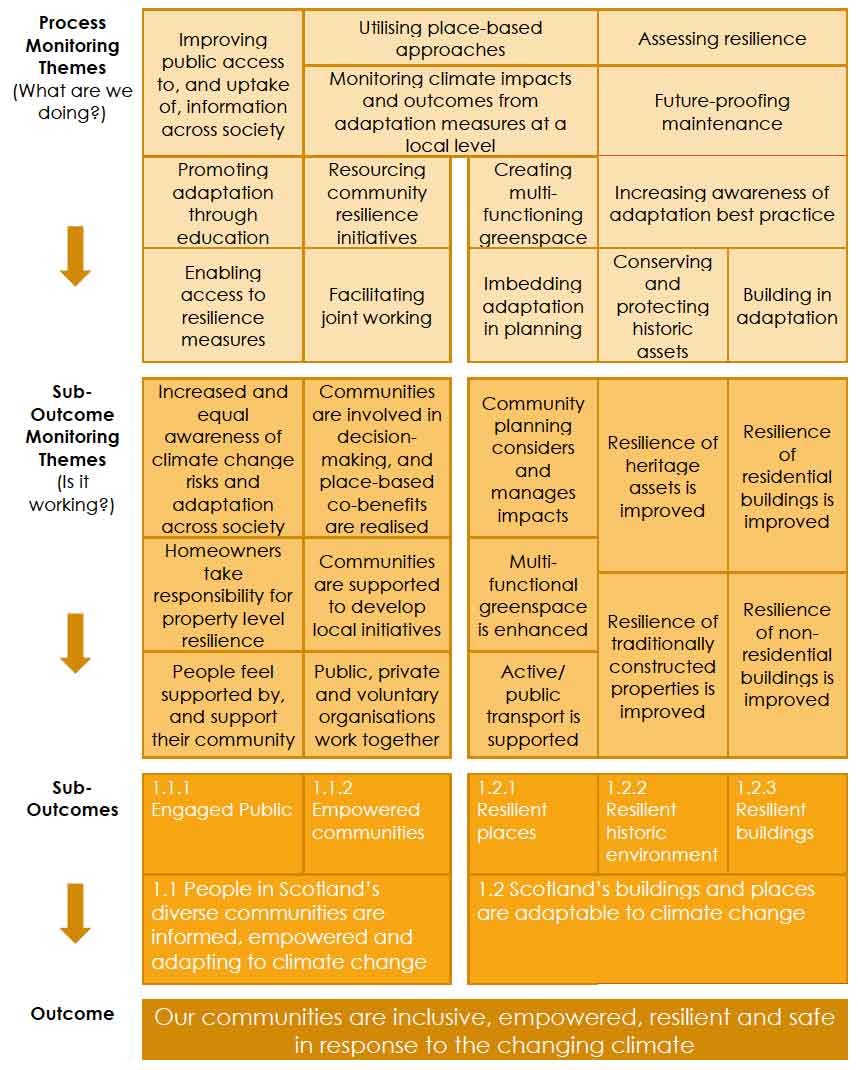
UK Climate Change Risk Assessment: Associated Risks
The UK Climate Change Risk Assessment risks that will be addressed by the policies presented in Outcome 1 are set out below:
| PB5: |
PB7: |
PB8: |
PB6: |
Contact
Email: roddy.maclean@gov.scot
There is a problem
Thanks for your feedback